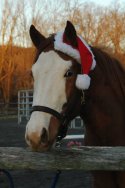|
EQUINE CLICKER TRAINING..... using precision and positive reinforcement to teach horses and people |
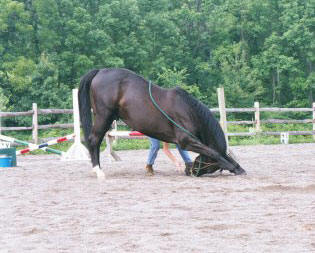

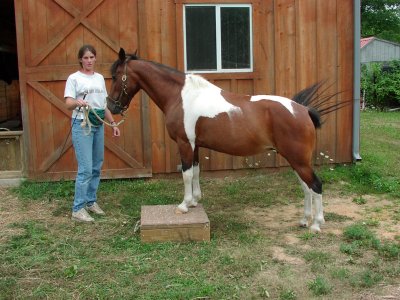
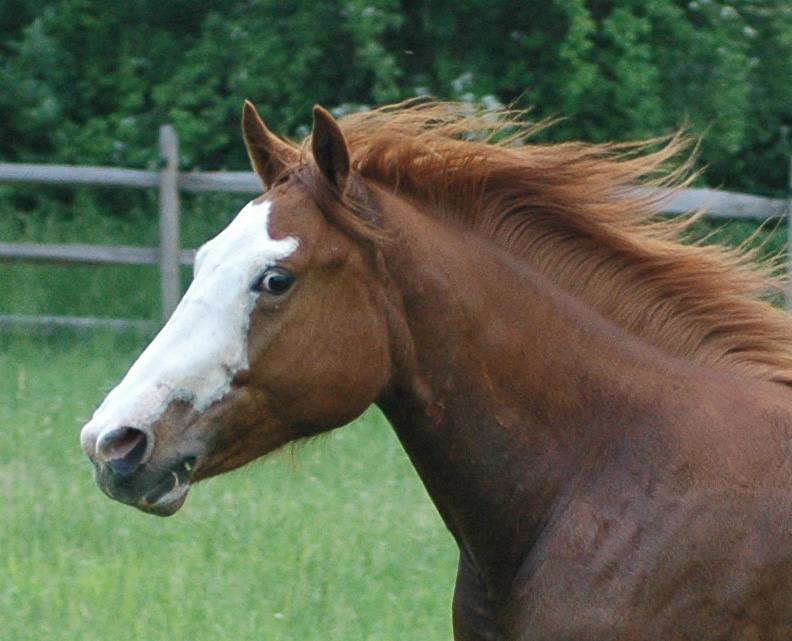
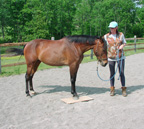
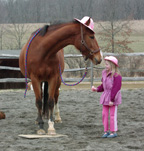
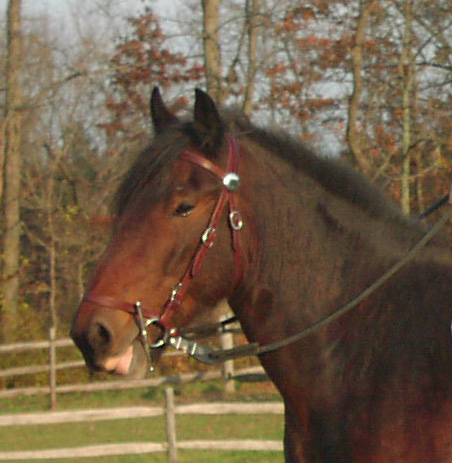
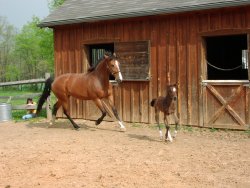 |
|
|
Clicker Horse Stories
One of my favorite things is hearing about how people have used clicker training to rehabilitate horses that were previously abused, mishandled or just misunderstood. At the clinics, each horse seems to have a story.† Many of us found clicker training because we were faced with a challenging horse that didnít respond to traditional handling.† I would like to create a collection of these stories here. They are a wonderful source of inspiration, encouragement, and ideas for those of us dealing with challenging horses. In addition, I would like to include any story about a clicker trained horse, even those that were performing satisfactorily with traditional handling.† These horses also changed through clicker training and became better partners and changed the way we view horse behavior and our relationships with them. If you have a story you would like me to include here, please email me at kabart315@gmail.com and I will be happy to post it here.
Their Stories: Brego Achilles Flash Brego by Margaret OíShaughnessy Brego is a beautiful 6yo Tennessee
Walker that may have had some ok early human contact, but was then left wild
for 4 years, and then not treated too well. There was absolutely no trust
in anything to do with people when he got here. His eyes were all
bulged out, his breathing was labored, and all of his muscles were hard as a
rock. The thing that struck me about him was what I saw underneath
all that fear. He has a very gentle nature; of everything he has been
through there has never been an offer to kick, bite, or even pin his ears * his
response to too much pressure or fear of things is to get the heck out of
dodge; but has never tried to go through the human to do that. This
impressed me. I have worked with abused horses before, and even semi wild
ones, but there was always some kind of defensive nature with them that
involved fighting back. When Brego takes treats from my hand it is most
delicate and he is still a gentleman after nine months of CT. He is also
good on the halter, and has been from the beginning. If he jumps from
something, it has never been into the person and he stops when he reaches the
end of the lead rope, not trying to pull out of my hand. Brego now looks forward to CT
sessions. When he sees me he comes right to the gate. For some time
he was still nervous on being caught and if I entered his pen, but I would CT
him for coming to me, which would relax him and I could then halter him.
He learned that head down would either get him a treat or a treat and complete
release of pressure * depending on what we were working on. He did not
like to be touched and for the longest time the only touch he would accept was
patting. So if I was working on touching him and he lowered his head he
would get a click AND I would take my hand away. I used this with hand
movement as well. I worked on his acceptance of my arms and hands moving
up, down, and side-to-side. Achilles arrived at my barn about 5 years ago as a 3 year old. A young girl had bought him thinking that the 3 year old was going to be like her old 23 year old thoroughbred and would happily and quietly walk on the trails. This was not to be! Achilles is a very large well-built 16.2 hh thoroughbred, and she was about 5í2Ē and not the most experienced rider. She kept getting bucked off. Go figure. I rode Achilles at her request to see how he was. He was a bit skittish about the latigos hanging from the western saddle, but although there was a thunder and lightning storm going full force, he never once offered to bolt or buck. He had a phenomenal personality, and loved people. She took a few lessons from me, but then decided he was too much horse for her, and sold her to the Mexican that worked at our ranch. For the next two years the horse was terrorized. The man would put him in the arena and make him run for 30-40 minutes to try to tire him out, then he would saddle him up, tie his head down, and go out for a bucking spree. When he came back from rides the horse would be dripping wet. He would wash him down with cold water without cooling him first, put him on the hotwalker, and make him trot on the hotwalker. When Achilles (or Poison as he named him in Spanish) started running away from him in the pasture when he went to get him, he decided to train him not to. He took a rope and tied his front legs together and left him that way for several hours. There was another horse in the pasture with him, and at feeding time, Wilmar put food out for the horses, and left. Achilles was unable to eat or drink at this point because he was unable to move. Several of us decided to take the initiative and release the horse. His legs were so swelled up he could barely walk. The guy also did things like make him jump in a chute until exhausted, and anytime he got bucked off, I almost didnít want to give him back. I knew Achillesí treatment would be worse if I didnít though. It finally got to the point where I threatened to call animal regulation and report him, so the owner of the ranch bought him back.† She then turned him over to another guy to train. This guyís idea of training was go out to the pasture with the bridle, donít brush, clean, anything. Throw a saddle on, rip up the cinch, never mind about that hair or skin, and then ride the horse. If the horse threatened to buck, you backed him up, did slide stops and rode in circles. Pretty soon Achilles wasnít coming to him either. I finally convinced the owner to let me work him. I rode him twice before he bucked me off. At that point I decided to really look at his behavior. Up till then, I hadnít heard about clicker training, but I had always used positive reinforcement on my horses, especially rehabs, and it had worked well. I saw that he was terrified of the saddle, the girth, didnít want anything to do with the bit, or the arena for that matter. I had gone to my treeless dressage saddle at this point, and tried to get away from anything that would remind him of his old training and treatment. Then revelation! I went to Equine Affaire, and caught the tail end of a clicker training demo. Hmmmm, I think that would work great! And it did! I started with targeting, which he caught on to right away, and just as quickly got bored with :) I started clicking him for remaining relaxed with the pad and then the saddle. He was fine with that, but it took nearly 3 months for him to stop leaping in the air when you touched him with the girth. I then started working with him in the arena. I decided to start over and let him free lunge. The first few times were less than successful. His only experience in the arena was that you ran around and didnít stop or else. I turned him loose and away he went. I tried stepping back and if he turned his head at all in my direction, I would click him. Up to this point he was coming to me right away, and if he heard the click he would come get his treat. Not today though. He would slow, and you could tell he wanted to come in, but he was too afraid to do the wrong thing, and so would just keep going. It took me quite a while to get him to slow down and come to me. Once he did though, it didnít take long for him to respond. Each step took a long time. He was so fearful when I first started girthing, that I had to shove the treats in his mouth. He totally blanked out, his eyes would glaze, his head would go up in the air, and his chin would quiver. It was terribly sad. I finally got him to respond when girthing, and when working him in the arena. I had to redo everything again when I started working him with the saddle in the arena, and then I had to train him to not freak out with the lunge whip. Poles terrorized him, and so did someone climbing on the rails of the arena and leaning over him. After several months of loving treatment and clicker training, he was transformed. Although he still was very difficult to ride, due to his fears, he was calm on the ground. You could climb up on the rails of the arena and he would come over and want to be petted. He learned to walk over ground poles, and would walk a pattern of them when you pointed. He learned to smile. I retrained him to lunge, and re-introduced the bit. He now grabs it out of your hand. All this has taken another year and a half to two years. I still have a long way to go, but Iím hoping that someday he will make a steady riding horse. Weíll see. Thereís a lot to un-do. In the meantime, heís leaning new tricks, bowing being one of them. Iíll have to stop his mugging the treat bag one of these days. At the time, I was thrilled to have him relaxed enough to want to mug. It seemed forever I was forcing the treats into his mouth! One womanís problem is another womenís happy moment I guess! In the meantime, the clicking goes on!
Before Flash, we had TB and Quarter horses, mostly for my daughter. I had just played a little bit with driving and a little bit with riding my 14.3 hh QH Rusty. Rusty was a difficult horse. You could be cantering along beautifully and then Rusty would stop for no apparent reason at all, and then jump sideways so most all people who rode him got off him. I was riding him and got hung up on the saddle horn when he did this, which hurt my leg pretty badly,† So, I sold Rusty to a walk rider. He is still with her and both are content just walking twice a year through the field. But I wanted a horse, so after watching Belgian draft horses being calm and nice, I bought a 4 year old Belgian gelding named Flash. At the time Flash was 17 HH and very calm. He was broke to drive single and double, did farm work and was very well behaved at the previous ownerís farm. So, after I rode and drove him several times, I bought him. He walked right on to the trailer, I brought him home. He walked right out of the trailer and proceeded to pull me all over the field. There was no stopping him.† He just decided he wanted to go one way and used his superior size to go there. It went downhill from there. He was ok to hitch up and he was ok to drive. When he was in the crossties he was good and very patient. But outside of them, forget it.† He chased me with teeth bared out of his stall and the only way we could walk him was with a big chain over his nose. The ground manners were not really his fault. He grew up with 36 Belgians who were all treated the same way. They were in standing stalls almost 24/7, got little exercise and were handled on the halter, not with a leadline. I was doing a little bit of clicker with my dogs and agility training so I was basically aware of the concept. I read Alexís book and taught Flash the basics of targeting a margarine cover. I never went farther then that. Then a heard that Alex was coming to a place near us and I signed Flash and myself up for the weekend. Up until this time, my daughter had to handle all the chores around Flash.† I was afraid to go in his stall and afraid to do much with him, besides sitting on him and walking around after she tacked him up for me. When we came home after that weekend, my daughter ran out of the house and wanted to help me unload him. I told her not to touch my horse again and that was the beginning of a wonderful relationship between Flash and me. Alex and especially Dolores spent all weekend teaching him manners. The first time, it took Alex 20 minutes to get him to stay at the other end of the stall when she was opening the door to feed him. The next time it took 3 minutes. Now I point to the corner, say corner and his head is glued to the wall and I click and release him. Like I mentioned before, he always decided where we were going to go. Not anymore. Now he stays politely next to me, he backs with the pointing of a finger and his head is down when I raise both of my hands to play with his ears and take burdocks out of his forelock. He knows a lot of voice commands, which is really handy with the driving. Last year he let himself and his two buddies out of the pasture (now everything is double locked) and got hit by a car. He had only a scratch, but the car had a lot of damage. It took only two clicker sessions to get him over the fear of cars on the road. Since he is so big I had a hard time putting his bridle in his mouth. It took four sessions and one container of sugar cubes for him to take the bit, keep his head down until I put everything over his ears and he is ready. I think this is the most admired task that we perform when other riders watch. I see so much struggling with putting bits in and everyone is envious that this big hunking horse is so accomadating. I show him in halter and driving
classes all over He is very attached to me, very jealous of any attention I give to the other horses and always happy to see me. With other people we still see the negative behavior a lot, with me none. I know without clicker training I
would not have him any more. I am buying a baby at the draft sale in January in
Flash is now 6, he has grown into a 17.3 HH 1800 lbs puppy (he is still growing). I love clicker training and get on people's nerves telling them about it all the time. I did presentations for 4H with him and taught him to bow in 3 minutes during one that demonstration. But the biggest hit was at Halloween. I was a pumpkin and Flash was the witch with a bicycle horn and holding his own trick or treat bag going around the neighborhood and blowing the horn at the door.
|

